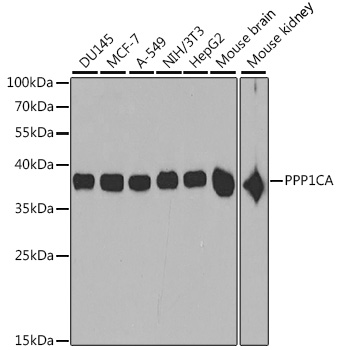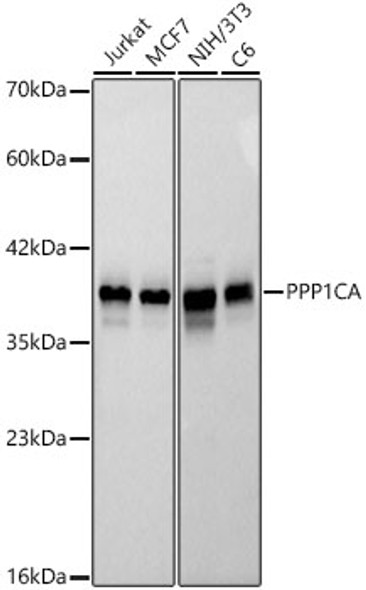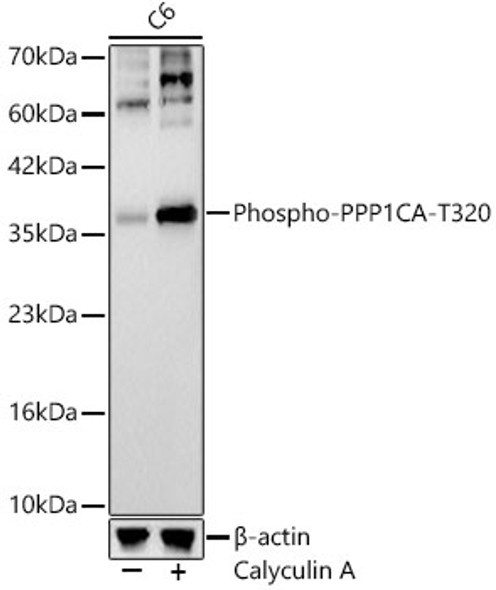Metabolism Antibodies 3
Anti-PPP1CA Antibody (CAB2184)
- SKU:
- CAB2184
- Product Type:
- Antibody
- Reactivity:
- Human
- Reactivity:
- Mouse
- Host Species:
- Rabbit
- Isotype:
- IgG
- Research Area:
- Metabolism
Description
| Antibody Name: | Anti-PPP1CA Antibody |
| Antibody SKU: | CAB2184 |
| Antibody Size: | 20uL, 50uL, 100uL |
| Application: | WB IF |
| Reactivity: | Human, Mouse |
| Host Species: | Rabbit |
| Immunogen: | Recombinant fusion protein containing a sequence corresponding to amino acids 1-330 of human PPP1CA (NP_002699.1). |
| Application: | WB IF |
| Recommended Dilution: | WB 1:500 - 1:2000 IF 1:50 - 1:200 |
| Reactivity: | Human, Mouse |
| Positive Samples: | DU145, MCF-7, A-549, NIH/3T3, HepG2, Mouse brain, Mouse kidney |
| Immunogen: | Recombinant fusion protein containing a sequence corresponding to amino acids 1-330 of human PPP1CA (NP_002699.1). |
| Purification Method: | Affinity purification |
| Storage Buffer: | Store at -20'C. Avoid freeze / thaw cycles. Buffer: PBS with 0.02% sodium azide, 50% glycerol, pH7.3. |
| Isotype: | IgG |
| Sequence: | MSDS EKLN LDSI IGRL LEVQ GSRP GKNV QLTE NEIR GLCL KSRE IFLS QPIL LELE APLK ICGD IHGQ YYDL LRLF EYGG FPPE SNYL FLGD YVDR GKQS LETI CLLL AYKI KYPE NFFL LRGN HECA SINR IYGF YDEC KRRY NIKL WKTF TDCF NCLP IAAI VDEK IFCC HGGL SPDL QSME QIRR IMRP TDVP DQGL LCDL LWSD PDKD VQGW GEND RGVS FTFG AEVV AKFL HKHD LDLI CRAH QVVE DGYE FFAK RQLV TLFS APNY CGEF DNAG AMMS VDET LMCS FQIL KPAD KNKG KYGQ FSGL NPGG RPIT PPRN SAKA KK |
| Gene ID: | 5499 |
| Uniprot: | P62136 |
| Cellular Location: | Cytoplasm, Nucleus, nucleolus, nucleoplasm |
| Calculated MW: | 32kDa/37kDa/38kDa |
| Observed MW: | 38kDa |
| Synonyms: | PPP1CA, PP-1A, PP1A, PP1alpha, PPP1A |
| Background: | The protein encoded by this gene is one of the three catalytic subunits of protein phosphatase 1 (PP1). PP1 is a serine/threonine specific protein phosphatase known to be involved in the regulation of a variety of cellular processes, such as cell division, glycogen metabolism, muscle contractility, protein synthesis, and HIV-1 viral transcription. Increased PP1 activity has been observed in the end stage of heart failure. Studies in both human and mice suggest that PP1 is an important regulator of cardiac function. Mouse studies also suggest that PP1 functions as a suppressor of learning and memory. Three alternatively spliced transcript variants encoding different isoforms have been found for this gene. |
| UniProt Protein Function: | PPP1CA: is a catalytic subunit of protein phosphatase 1 (PP1), aubiquitous cytosolic serine-threonine phosphatase. Composed of a catalytic subunit (PPP1CA, PPP1CB or PPP1CC) which is folded into its native form by inhibitor 2 and glycogen synthetase kinase 3, and then complexed to one or several targeting (or regulatory) subunits: PPP1R12A and PPP1R12B mediate binding to myosin; PPP1R3A, PPP1R3B, PPP1R3C and PPP1R3D mediate binding to glycogen; and PPP1R15A and PPP1R15B mediate binding to EIF2S1. PP1 is essential for cell division, plays critical roles in many cellular processes including glycogen metabolism, muscle contractility and protein synthesis, and is involved in the regulation of ionic conductances and long-term synaptic plasticity. Inhibits the synthesis of proteins involved in synaptic plasticity. Binds to the transcription factor cyclic AMP-dependent response element binding (CREB) and dephosphorylates it. May regulate chromatin condensation through regulation of histone H3 phosphorylation. Differentially expressed in gastric cancer. May participate in the neurodegenerative progress in Alzheimer's disease. Down-regulated in lung squamous cell carcinoma. |
| UniProt Protein Details: | Protein type:EC 3.1.3.16; Nucleolus; Protein phosphatase, Ser/Thr (non-receptor) Chromosomal Location of Human Ortholog: 11q13.2 Cellular Component: cell-cell adherens junction; cytoplasm; cytosol; nuclear chromosome, telomeric region; nucleoplasm; nucleus; plasma membrane Molecular Function:phosphoprotein phosphatase activity; phosphoric monoester hydrolase activity; protein binding Biological Process: circadian regulation of gene expression; dephosphorylation; entrainment of circadian clock by photoperiod; negative regulation of protein binding; protein amino acid dephosphorylation; regulation of circadian rhythm |
| NCBI Summary: | The protein encoded by this gene is one of the three catalytic subunits of protein phosphatase 1 (PP1). PP1 is a serine/threonine specific protein phosphatase known to be involved in the regulation of a variety of cellular processes, such as cell division, glycogen metabolism, muscle contractility, protein synthesis, and HIV-1 viral transcription. Increased PP1 activity has been observed in the end stage of heart failure. Studies in both human and mice suggest that PP1 is an important regulator of cardiac function. Mouse studies also suggest that PP1 functions as a suppressor of learning and memory. Three alternatively spliced transcript variants encoding different isoforms have been found for this gene. [provided by RefSeq, Jul 2008] |
| UniProt Code: | P62136 |
| NCBI GenInfo Identifier: | 49065811 |
| NCBI Gene ID: | 5499 |
| NCBI Accession: | P62136.1 |
| UniProt Secondary Accession: | P62136,P08129, P20653, P22802, Q07161, A6NNR3, B2R908 |
| UniProt Related Accession: | P62136 |
| Molecular Weight: | Calculated MW: 32kDa/37kDa/38kDaObserved MW: 38kDa |
| NCBI Full Name: | Serine/threonine-protein phosphatase PP1-alpha catalytic subunit |
| NCBI Synonym Full Names: | protein phosphatase 1 catalytic subunit alpha |
| NCBI Official Symbol: | PPP1CA |
| NCBI Official Synonym Symbols: | PP1A; PP-1A; PPP1A; PP1alpha |
| NCBI Protein Information: | serine/threonine-protein phosphatase PP1-alpha catalytic subunit |
| UniProt Protein Name: | Serine/threonine-protein phosphatase PP1-alpha catalytic subunit |
| Protein Family: | Serine/threonine-protein phosphatase |
| UniProt Gene Name: | PPP1CA |
View AllClose






![PPP1CA Monoclonal Antibody [P4G3AT] (CPAB0159) PPP1CA Monoclonal Antibody [P4G3AT] (CPAB0159)](https://cdn11.bigcommerce.com/s-rd6ounxcu2/images/stencil/590x590/products/58385/63567/ppp1ca-monoclonal-antibody-p4g3at-cpab0159__38651__13732.1706534993.jpg?c=1)
